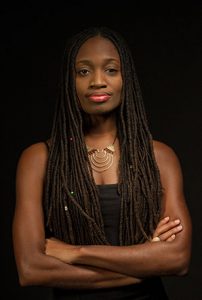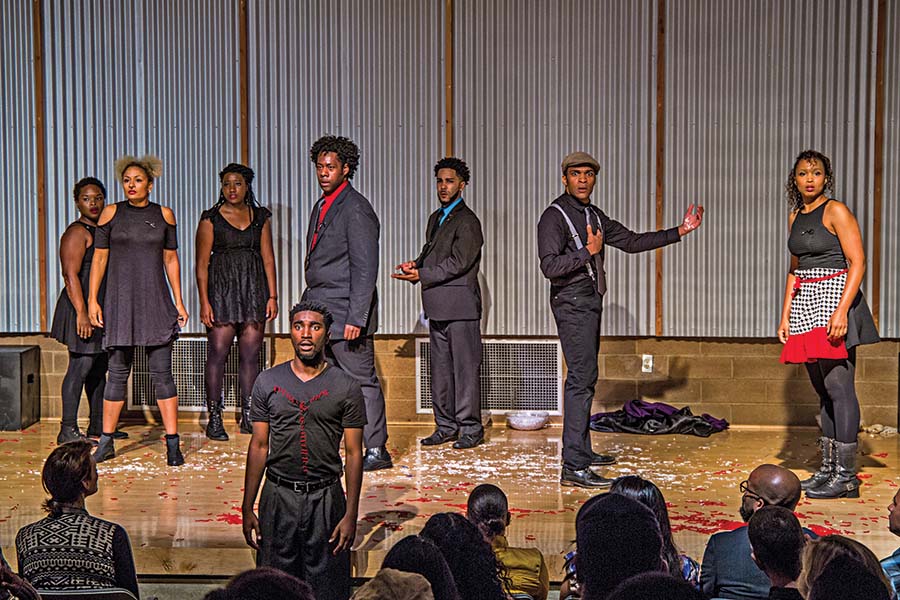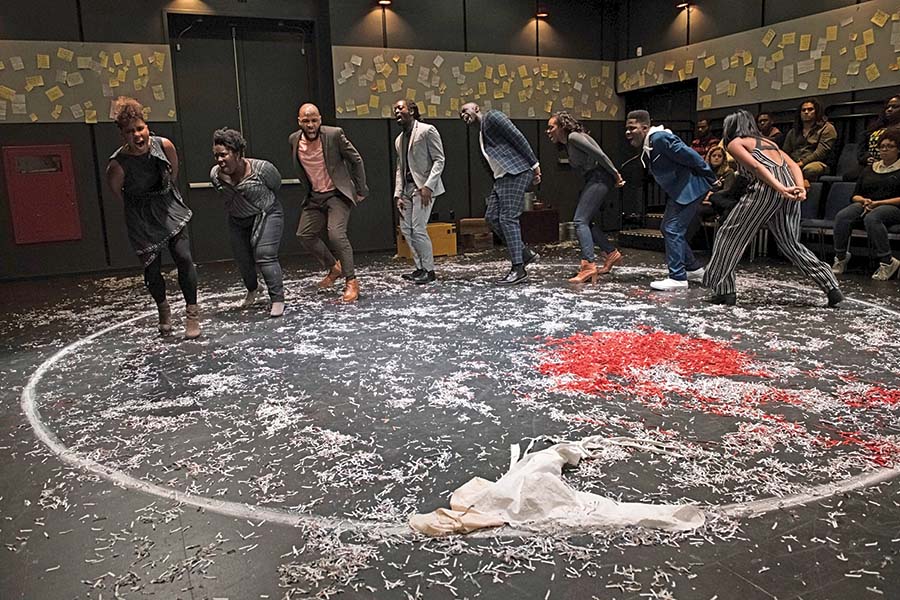
In a prologue to Aleshea Harris’s What to Send Up When It Goes Down, a group of Black performers unapologetically announces that it is “for Black people.” Framed as a kind of ritual, the show offers an array of scenes touching on police brutality, microaggressions, and racial resentment. First written and directed by Harris in 2016, it was mounted last fall by Off-Broadway’s Movement Theatre Company to great acclaim. The play has been reprinted, in full, in the April 2019 issue of American Theatre (which can be purchased here).
BRANDEN JACOBS-JENKINS: Your other plays exist in a hermetic kind of space of “story,” where Blackness is centered without self-consciousness and language is an important part force—not just in the way that people express themselves but in the way it literally gives shape to the play world. What to Send Up works with similar methods but looks and feels very different. Was this formal departure conscious on your part?
ALESHEA HARRIS: I just wanted to do something that was activated, something an audience couldn’t just passively experience. I knew this piece would have to do with Black people being killed by police officers with impunity. The idea was to hold people accountable, be confrontational, let it be messy, let it be angry, and let it tread as absurdly as the idea that a Black person could be killed on camera unarmed and the person who killed them get away with it. That is an absurd reality. I wanted to mirror that absurdity in the form of the play.
I also wanted to be really clear about rage, because rage and anger are central to a lot of my work. This has to do with the cultural pressure for me not to be angry, or the ways that, since I was a little girl, I received a message that anger wasn’t something that I could hold onto. I’m going off on a tangent. I hope that’s okay.
I’m into this tangent.
We’re mad and we have a right to be mad, because the gaslighting of anti-Blackness is: “You imagined that.” Or “It’s really about economics, not race.” There are so many ways people duck and dodge the uncomfortable reality that anti-Blackness is ingrained in the fabric of our country . I wanted it to be a no-gaslighting space. Black people feel however they feel and that’s okay in this space, and should be okay in the world. And since I am having a Black woman’s experience as a human on this planet, I know very well that there’s this stereotype, there’s this mythology about Black women being mad. In order to challenge that, there’s pressure from the community for us not to be mad, to be something else, to be a carefree Black girl. I’m not interested in being bound by either of those pressures/expectations. I just want to be my authentic self.
One of the moments in the show that I can’t stop thinking about was this exercise in the beginning when we have to stand in a circle and step in or out of it based on who had had what kinds of personal experiences. I had this crazy moment when it got to the one about whether or not you have had a gun being pointed at you by an officer of the law. I stepped forward, but I was one of only three people in the sold-out audience who stepped forward. And suddenly I felt this palpable gulf between myself and people that I knew. It was a pretty frightening experience in college that I’d actually suppressed, and it had never quite occurred to me to think about it the context of anti-Blackness, probably because I got out of it relatively unscathed. But that moment in the circle to me was like: Oh my God, I’m experiencing the definition of catharsis! A thing is being brought up in me that I had buried that I’m now being given permission to meditate on and expunge!
But then I wondered: Was my experience in that moment being categorized or demarcated as “essentially” Black in some way? Because a lot of Black people didn’t step forward. It made me really interested in hearing you talk about your concept of Blackness. Do you believe that Blackness is a thing one chooses? Is it something rooted in trauma, historical or otherwise? Are the lines around racial identity very clear cut for you and very defined? Are these moments of ambiguity and fluidity important to you?
The prompts invite people to step forward if they’re Black and have had the experience described. Certainly, some Black people have been held at gunpoint by police and some haven’t. When I think about Blackness in relation to this piece, I usually am thinking about what it means to move through space and be perceived as Black and the things that come along with that perception. But if I’m strictly using that definition, then people who are “passing”—it wouldn’t apply to them, and it is wrong to deny them that. People self elect in response to the prompts. It isn’t my job to police anyone’s identity.
Without spoiling too much, this play ends with a kind of active divvying up of the audience along racial lines, but it doesn’t seem interested in making a spectacle out of it. And I remember at the end a feeling of giddiness among everyone who was left in the theatre. Everyone became sort of silly and childish; it was actually very moving in some ways—its own kind of catharsis. I’m curious how that final gesture came to you. Is it something that came out of the rehearsals themselves, or was it always a part of the writing of the piece itself?
Unfortunately it has not always been a part of the piece. The New York production was the first iteration of What to Send Up where that has happened. I’ve mounted it maybe two or three times in California. I found that last moment with a nudge from this iteration’s producers, the Movement Theatre Company. The idea was to make sure we were taking a specific space just for Black folks, a space that wasn’t leaving the wound open. I wanted something around community and something around the kind of safety we can feel, the kind of giddiness you’re describing when it’s just us and it’s about us. We have marginalized the thing that typically marginalizes us.
I was very conscious of the necessity of asking non-Black people to leave the space. I didn’t want to make a performance of Black people through something for the viewership of non-Black people.
That’s such an interesting idea. I think I’m probably of that school that wonders about how Blackness as a concept is historically defined in proximity Whiteness and vice versa. If there are a bunch of Black people in the room and there are no white people, are those people still “Black”? I wonder if this is something you’re gesturing towards.
There’s something about the way we breathe easy when it’s just us. I think that it has to do with what you described, which is that suddenly, without white people, there’s an absence of Blackness, and we get to be human in a different way. I think the piece is about our humanity.
I’ve asked myself again and again how the piece operates if there are no white people in the audience. Is it still useful? What does it become? I think that it’s find that it is still useful, because the exercise of being together and saying these things, affirming one another, is very necessary. I know I need to refuel the tank sometimes.

It’s such an intriguing play text. In your play Is God Is, you experimented so effectively with typography. I’m curious if you think about the formatting of your script and the experience of reading as something very separate from the experience of the work itself—I’m thinking of how Tennessee Williams, for instance, would write these gorgeous, poetic, almost novelistic stage directions. O’Neill too.
It varies from piece to piece. The way that I approached Is God Is was with so much interest in how I could use language, the performance of language on the page, to deepen what I was up to, to experiment with something, to send signals to collaborators. With What to Send Up, since I started out, directing it for the past few years in California—there’s a way that it feels like a letter I wrote to myself. I had to clean up the stage directions for Whitney White, who directed it in New York. In my previous version, I realized I wasn’t leaving any decisions up to the new director.
How do you refer to “episodes” within the piece? You have this frame of ritual, but the content’s almost like Grotowski or Reza Abdoh on Black acid. (Is Black acid a thing?) How do you think the characters Made and Miss and Driver? Are they characters to you or are they something else?
I refer to the episodes as “movements,” like in music. And the characters (i.e., Made/Miss/Driver) are being put on like costumes by Black people who need to do it in order to get free by the end of the piece. So I do a lot of telling the performers or the participants—sometimes I call them participants—that they aren’t losing themselves in a character. There’s a sheen and a commentary on this character that you are bringing with your body.
If we think about other rituals, like a preacher coming to lead a worship service, the preacher isn’t pretending to be a preacher. They’re doing that thing. They’re preaching. What I was after was people doing things that were meant to bring something into being, which is what ritual is. At this moment I need to do this thing and say these words, so that by the end, I get to this space where I can dance with my people and feel free.
Do you have a way that you articulate how the act of play acting frees someone, frees a being? What is it about the reenactment of these ideas or these scenelets? What’s the magic that they work on the body?
I think that it works because there’s a way that it says: This thing happened. Right? I’ve asked myself, for sure, what does it mean to recreate a Black person being shot? I think there’s a way that it says to everyone in this space, though it’s abstract and it’s aestheticized: This happens. I also think there’s something about getting to carry out or feel emotion that one can’t carry out in one’s real life. If people get to yell in that space, there’s something healthy about that. I can’t yell, for example, every time I experience some microaggression. So it’s healing, it’s cathartic, and it’s useful for me to get to yell in the theatre with What to Send Up.


